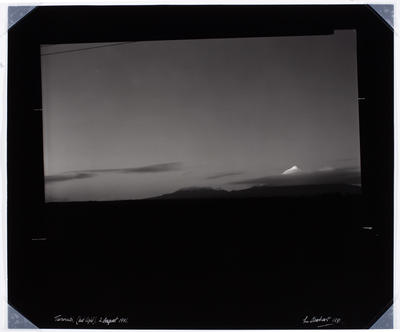A distant view of Taranaki from the mouth of the Wanganui River;...
-
Laurence Aberhart
b.1949

Title
A distant view of Taranaki from the mouth of the Wanganui River; at dusk 3 February 1986
Details
| Production Date | 1986 |
|---|---|
| Collection(s) | Collection Govett-Brewster Art Gallery, New Plymouth |
| Accession Number | 86/6 |
| Media | Silver bromide gelatin print |
| Measurements | Framed: 425 x 463 x 25mm; 250mm x 299mm |
About
Laurence Aberhart’s A Distant View of Taranaki is one of many images the photographer has made of the mountain. Aberhart has photographed Taranaki repeatedly, almost obsessively, but in his images the mountain remains elusive, often obscured by distance or veiled by clouds or smoke. A Distant View of Taranaki was taken at Whanganui, looking out across the sea of the South Taranaki Bight. The mountain which dominates the landscape of the Taranaki region is a tiny blip on the dark horizon, barely distinguishable from the developing clouds. Seen from this perspective, Taranaki exists on the threshold between dark and light, reaching up from the land towards the still-glowing evening sky.
The photographer’s position at the mouth of the Whanganui River recalls the most well known of the Māori stories about the river’s creation. According to tradition, Mount Taranaki once lived with Ruapehu, Ngāuruhoe and Tongariro in the centre of the North Island. However, Taranaki and Tongariro both fell in love with the beautiful mountain, Pihanga. Taranaki was defeated in the ensuing battle, and fled to the coast, his movement gouging out the deep furrow of the river. He maintains his lonely vigil on the coast to this day, separated from his beloved Pihanga and his former mountain companions.
Aberhart’s image contains some of solitary Taranaki’s melancholy, but also nostalgia of a different kind. A Distant View of Taranaki is a silver gelatin print, made using photographic technology that was outdated in the 1960s. Aberhart is steadfast in his use of archaic photographic equipment, including a century-old, large-format camera which requires extremely long exposure times and difficult, time-consuming processes but can produce images of remarkable delicacy and sharpness. This anachronistic art form seems suitable, as the photographer looks westward at dusk towards the last of the light.


